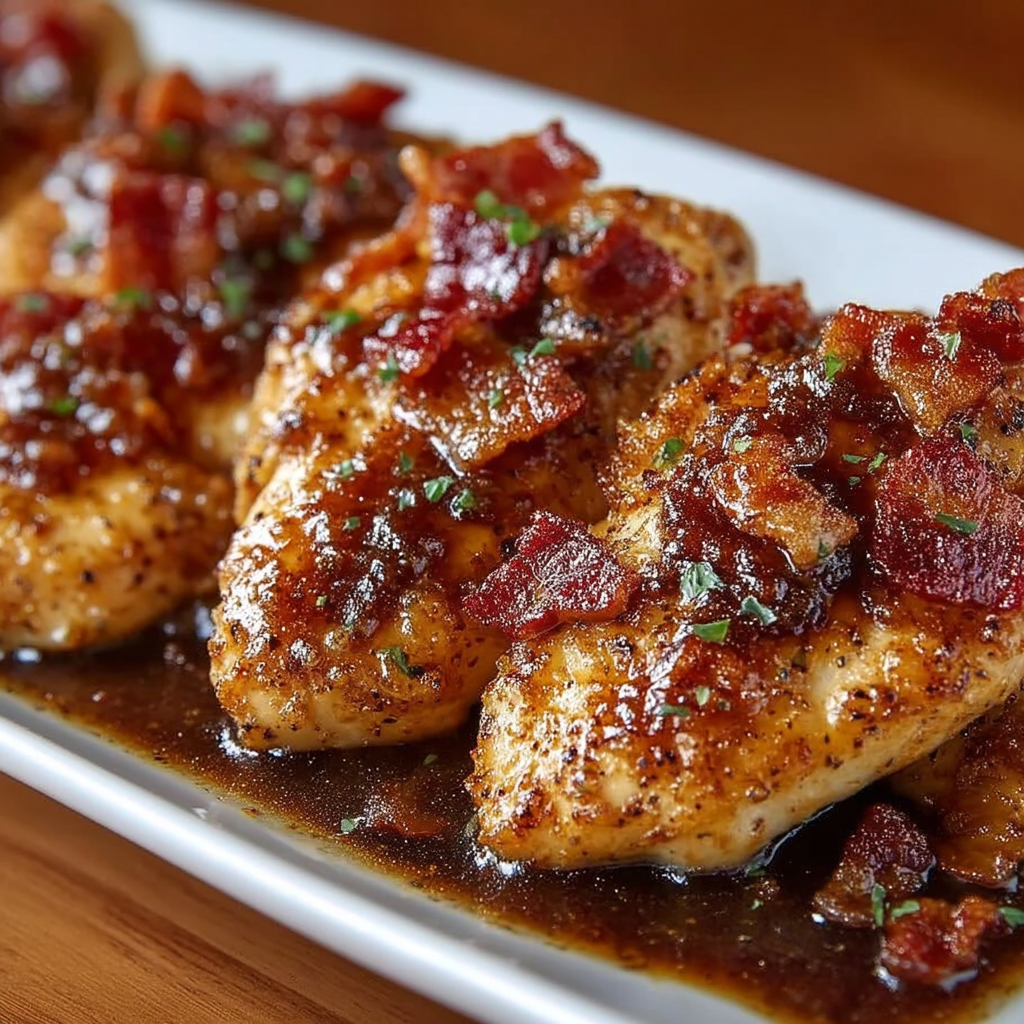Introduction to recipe
Honey Garlic Bacon Chicken is a savory-sweet dish that elevates classic succulent chicken breasts with crispy bacon, mellow garlic, and a glaze that’s both sticky and richly flavorful. If you’re seeking a dish that balances comfort with sophistication, this recipe is a perfect addition to your weekly rotation or weekend dinner celebration. The combination of honey, soy, Dijon mustard, and apple cider vinegar strikes an exquisite chord between sweetness, tang, and umami—a trifecta that keeps every bite memorably delicious.
This dish also fits neatly into a well-planned cooking strategy. For instance, Serious Eats explains how building flavor in pan sauces can drastically elevate even the simplest chicken dish—like this one. Additionally, if you want more inspiration around bacon-enhanced dinners, this Food Network roundup of bacon recipes offers a wide range of creative, indulgent ideas.
Bringing together tender chicken breasts, crisp bacon pieces, and an enveloping sauce, Honey Garlic Bacon Chicken is as pleasing to the eye as it is to the palate.
Basic Recipe: Ingredients and Instructions
Print
Honey Garlic Bacon Chicken Recipe – Sweet, Savory & Crispy Perfection
Description
This Honey Garlic Bacon Chicken recipe features crispy bacon, juicy chicken breasts, and a sweet-savory garlic glaze. Perfect for weeknight dinners or meal prep, with storage tips, dietary swaps, and pro techniques.
Ingredients
-
4 boneless, skinless chicken breasts
-
6 slices thick‑cut bacon, chopped
-
1/2 cup flour (for dredging)
-
1 teaspoon salt
-
1/8 teaspoon black pepper
-
1 tablespoon olive oil
-
6 cloves garlic, minced
-
1/3 cup honey
-
1/4 cup soy sauce
-
1 tablespoon apple cider vinegar
-
1 tablespoon Dijon mustard
-
Fresh parsley, chopped (garnish)
Instructions
-
Prepare the chicken: Pat the chicken breasts dry. In a shallow dish, mix flour, salt, and pepper. Dredge each breast lightly to coat.
-
Cook the bacon: In a large skillet over medium heat, add chopped bacon. Cook until golden‑brown and crispy. Remove bacon with a slotted spoon and set aside, leaving the rendered fat in the pan.
-
Sear the chicken: Increase heat to medium‑high, add olive oil to the bacon fat. Once hot, sear chicken breasts for about 4–5 minutes per side until golden; transfer to a plate.
-
Make the sauce: Lower heat to medium, add minced garlic to the pan and cook until fragrant (about 30 seconds). Stir in honey, soy sauce, apple cider vinegar, and Dijon mustard. Whisk thoroughly.
-
Glaze the chicken: Return chicken breasts and bacon to the pan. Coat with the sauce and simmer for 5–7 minutes, occasionally spooning sauce over, until chicken is cooked to an internal temperature of 165 °F (74 °C) and sauce is slightly thickened.
-
Serve: Transfer chicken to a serving platter, spoon extra glaze over, sprinkle with chopped parsley, and serve immediately while luscious and glistening.
Notes
If your chicken breasts are thick on one side and thin on the other, use a meat mallet or rolling pin to gently pound them to an even thickness. This ensures even cooking and helps prevent dryness.
Advanced Techniques
1. Reverse searing for perfect doneness
Start by roasting the chicken breasts in a preheated oven at 200 °F till they reach about 140 °F internally, then finish by searing in the skillet with bacon fat. This method ensures even cooking and beautifully caramelized exterior without over‑cooking the juicy interior. It takes slightly longer, but yields more precise doneness and less risk of dryness—an especially beneficial method if you’re cooking thicker chicken breasts.
2. Bacon fat infusion technique
Instead of using both olive oil and bacon fat separately, render bacon in the skillet, then strain and reserve the fat. Use that pure, aromatic fat to sear the chicken—this deepens the flavor dramatically. After searing, pour off excess fat if it’s too much, saving a thin layer. Then proceed with the garlic and sauce. The infusion of salty, smoky fat into the glaze enriches every layer of flavor.
3. Honey‑soy reduction
After adding honey, soy sauce, Dijon, and vinegar, let the sauce reduce more aggressively on medium‑low heat—about 8–10 minutes until slightly syrupy. Stir occasionally to prevent burning. A thicker, concentrated glaze clings to the chicken and bacon, creating a more intense flavor profile and a better mouth‑feel. Watch closely to avoid crystallizing the sugars.
4. Garlic blooming process
Lower the heat and add the garlic before the other liquids. Let it gently “bloom” in the fat for a full minute, stirring continuously, until it’s fragrant but not browned. This step mellows the raw garlic’s sharpness, releasing a soft, aromatic base into the sauce rather than a harsh bite.
5. Finishing with a flavor brine
For an even more flavor‑infused result, brine the chicken breasts in a simple salt and sugar solution (½ cup water, 1 tablespoon salt, 1 teaspoon sugar) for 30 minutes before dredging. Rinse and pat dry, then proceed with flour dredge. The brine boosts juiciness and seasoning in the meat itself—not just on the surface—adding depth to each bite and enhancing the interplay with the bacon glaze.
See more advanced recipes at cookingwhite.com
Storage, Shelf Life, and Maintenance Tips
1. Refrigeration best practices
Allow the chicken and gravy to cool to near-room temperature before refrigeration—this prevents condensation and soggy skin. Place in an airtight container and refrigerate promptly. Properly stored, the dish remains safe and delicious for up to 3–4 days. Reheat gently to preserve texture rather than microwaving aggressively.
2. Freezing safely
Portion the chicken with glaze into freezer-safe containers, leaving a little headspace. Freeze for up to 2 months. When ready to enjoy, thaw overnight in the refrigerator, then reheat in an oven at 325 °F (160 °C) covered with foil to keep moisture, or gently on the stovetop. This method retains much of the original flavor and succulence.
3. Reheating without drying
Reheat on medium-low heat on the stovetop, spooning up sauce from the bottom to recoat the chicken as it warms. Alternatively, wrap in foil and bake—uncovered at the end to refresh the glaze. Avoid microwave reheating, which can turn chicken rubbery and disturb bacon crispness.
4. Sauce preservation tip
If you foresee leftovers, reserve a bit more sauce and store separately from the chicken. This prevents the breadcrumb texture from becoming overly soggy as it soaks. When reheating, warm sauce gently in a small saucepan until just fluid and spoon over chicken for a fresh finish.
5. Maintain bacon crispness
To preserve bacon’s crisp texture, set aside bacon pieces on a paper towel–lined plate before storing. If first stored mixed in the dish, reheat bacon alone briefly in a hot oven or skillet to re-crisp before combining just before serving again, for satisfying crinkle and flavor contrast.
Dietary Adaptations and Substitutions
1. Gluten‑free option
Swap the regular flour for a 1:1 gluten‑free all‑purpose flour or cornstarch for dredging. Ensure your soy sauce is tamari or certified gluten‑free. These substitutions maintain the golden crust while accommodating gluten sensitivities without sacrificing flavor.
2. Low‑sodium adaptation
Use low‑sodium soy sauce and reduce added salt in the dredge mixture. Opt for sugar‑free or light honey, and perhaps increase garlic or Dijon to compensate for flavor. This cuts sodium content while still preserving rich umami from the bacon and soy, perfect for salt‑conscious diets.
3. Maple‑garlic vegan alternative
For a vegan take, substitute chicken breasts with thick seitan or tofu steaks; replace bacon with smoky tempeh strips or coconut bacon. Use maple syrup instead of honey and tamari for soy sauce. The technique remains similar, creating a plant-based version that’s sweet, smoky, and tender.
4. Keto‑friendly tweak
Skip the flour dredge, or use almond meal or crushed pork rinds for a low-carb crust. The rest of the ingredients are keto-compatible: bacon, garlic, honey (available as keto-friendly alternatives like allulose or erythritol syrup), soy sauce, vinegar, Dijon. This allows a nearly carb-free indulgence.
5. Paleo adaptation
Use coconut flour or arrowroot for dredging instead of wheat flour. Choose pure honey, coconut aminos instead of soy sauce, and avoid apple cider vinegar if highly strict—substitute with lemon juice as a paleo‑friendly acid. These tweaks keep the dish Paleo and grain‑free while retaining the signature honey-garlic balance.
FAQs About The Recipe
1. Can I use chicken thighs instead?
Absolutely! Boneless, skinless chicken thighs are slightly more forgiving and juicier than breasts. Reduce cook time slightly, and ensure proper internal temperature (165 °F). Their extra fat also enhances flavor, especially when paired with bacon and glaze.
2. Why did my sauce get grainy or crystallize?
Excess high heat can cause the sugars in honey to crystallize. To avoid this, reduce sauce at medium-low heat, stir frequently, and don’t over-thicken. Also, if reheating, add a splash of liquid (water or broth) to revive the glaze’s smooth texture.
3. How do I prevent chicken from sticking to the pan?
Ensure your pan and bacon fat are adequately hot before adding the chicken. Preheat until shimmering, then carefully place dredged chicken without overcrowding. If it still sticks, let it sear undisturbed for an extra minute to naturally release before flipping.
4. Can I make this in the slow cooker?
Yes, for convenience, brown bacon and chicken in a skillet first, then transfer to a slow cooker. Add garlic and sauce ingredients, cook on low for 3–4 hours or high for 1.5–2 hours. Finish by searing chicken briefly to restore glaze thickness and texture, if desired.
5. How spicy is this dish, and can I add heat?
As written, the recipe is not spicy. To introduce warmth, add a pinch of crushed red pepper flakes while cooking the garlic, or stir in a teaspoon of sriracha or chili paste. Adjust to your preference—start with small increments to maintain sweet-savory balance.
Conclusion & Final thoughts
Honey Garlic Bacon Chicken is a standout recipe that marries sweet, savory, and smoky flavors into a harmonious main dish that’s both unexpectedly simple and incredibly satisfying. Its layers of taste—the crisp bacon, aromatic garlic, luscious honey‑soy glaze, and delicate Dijon tang—are what allow it to serve as both a comforting weeknight supper and an elegant dish for entertaining. By using basic pantry ingredients like honey, soy sauce, garlic, and Dijon mustard, elevated by the smoky depth of bacon, this recipe becomes both approachable and memorable.
In the Basic Recipe, you’re given a clear and reliable set of steps—from dredging and searing to glazing—that ensures consistently tasty results. But the value lies in the optional Advanced Techniques, where reverse searing adds precision, bacon fat infusion enhances flavor, and brining boosts moisture. These methods help you turn a tried-and-true formula into a mastered craft.
Moreover, this chicken dish is adaptable: whether you’re gluten-free, low‑sodium, keto, paleo, or vegan, there are thoughtful substitutions that maintain the essential experience without sacrificing taste. This flexibility makes the recipe ideal for diverse dietary needs, making it a versatile choice for families or dinner parties with mixed preferences.
Practical guidance on Storage, Shelf Life, and Maintenance ensures you can enjoy leftovers at their best—whether stored in the fridge for a few days or frozen for longer-term planning—while preserving texture and flavor.
The FAQs section anticipates common questions: swapping chicken thighs, avoiding crystallized sauce, tackling sticking pans, converting to slow cooker, or dialing in some heat—all help you troubleshoot and customize with confidence.
Ultimately, Honey Garlic Bacon Chicken isn’t just a meal; it’s a flavorful experience—rich, balanced, deeply satisfying—and built on simple techniques with extraordinary results. Whether you’re feeding family, spotlighting a dinner gathering, or approaching weeknight cooking efficiently, this recipe delivers on all fronts. May your kitchens be filled with the mouthwatering aroma of garlic-sweet-glazed bacon‑kissed chicken, and may each tender bite bring joy.

